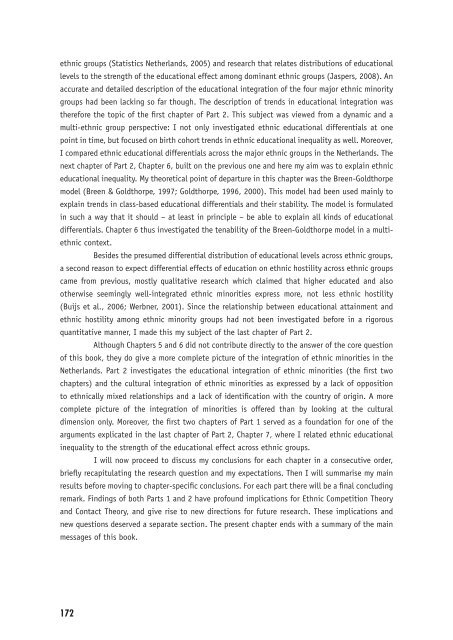Ethnic Hostility among Ethnic Majority and Minority Groups
Ethnic Hostility among Ethnic Majority and Minority Groups
Ethnic Hostility among Ethnic Majority and Minority Groups
You also want an ePaper? Increase the reach of your titles
YUMPU automatically turns print PDFs into web optimized ePapers that Google loves.
ethnic groups (Statistics Netherl<strong>and</strong>s, 2005) <strong>and</strong> research that relates distributions of educational<br />
levels to the strength of the educational effect <strong>among</strong> dominant ethnic groups (Jaspers, 2008). An<br />
accurate <strong>and</strong> detailed description of the educational integration of the four major ethnic minority<br />
groups had been lacking so far though. The description of trends in educational integration was<br />
therefore the topic of the fi rst chapter of Part 2. This subject was viewed from a dynamic <strong>and</strong> a<br />
multi-ethnic group perspective: I not only investigated ethnic educational differentials at one<br />
point in time, but focused on birth cohort trends in ethnic educational inequality as well. Moreover,<br />
I compared ethnic educational differentials across the major ethnic groups in the Netherl<strong>and</strong>s. The<br />
next chapter of Part 2, Chapter 6, built on the previous one <strong>and</strong> here my aim was to explain ethnic<br />
educational inequality. My theoretical point of departure in this chapter was the Breen-Goldthorpe<br />
model (Breen & Goldthorpe, 1997; Goldthorpe, 1996, 2000). This model had been used mainly to<br />
explain trends in class-based educational differentials <strong>and</strong> their stability. The model is formulated<br />
in such a way that it should – at least in principle – be able to explain all kinds of educational<br />
differentials. Chapter 6 thus investigated the tenability of the Breen-Goldthorpe model in a multiethnic<br />
context.<br />
Besides the presumed differential distribution of educational levels across ethnic groups,<br />
a second reason to expect differential effects of education on ethnic hostility across ethnic groups<br />
came from previous, mostly qualitative research which claimed that higher educated <strong>and</strong> also<br />
otherwise seemingly well-integrated ethnic minorities express more, not less ethnic hostility<br />
(Buijs et al., 2006; Werbner, 2001). Since the relationship between educational attainment <strong>and</strong><br />
ethnic hostility <strong>among</strong> ethnic minority groups had not been investigated before in a rigorous<br />
quantitative manner, I made this my subject of the last chapter of Part 2.<br />
Although Chapters 5 <strong>and</strong> 6 did not contribute directly to the answer of the core question<br />
of this book, they do give a more complete picture of the integration of ethnic minorities in the<br />
Netherl<strong>and</strong>s. Part 2 investigates the educational integration of ethnic minorities (the fi rst two<br />
chapters) <strong>and</strong> the cultural integration of ethnic minorities as expressed by a lack of opposition<br />
to ethnically mixed relationships <strong>and</strong> a lack of identifi cation with the country of origin. A more<br />
complete picture of the integration of minorities is offered than by looking at the cultural<br />
dimension only. Moreover, the fi rst two chapters of Part 1 served as a foundation for one of the<br />
arguments explicated in the last chapter of Part 2, Chapter 7, where I related ethnic educational<br />
inequality to the strength of the educational effect across ethnic groups.<br />
I will now proceed to discuss my conclusions for each chapter in a consecutive order,<br />
briefl y recapitulating the research question <strong>and</strong> my expectations. Then I will summarise my main<br />
results before moving to chapter-specifi c conclusions. For each part there will be a fi nal concluding<br />
remark. Findings of both Parts 1 <strong>and</strong> 2 have profound implications for <strong>Ethnic</strong> Competition Theory<br />
<strong>and</strong> Contact Theory, <strong>and</strong> give rise to new directions for future research. These implications <strong>and</strong><br />
new questions deserved a separate section. The present chapter ends with a summary of the main<br />
messages of this book.<br />
172












